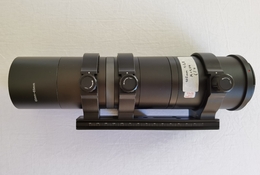manfrominternet
Member
Hello fellow photographers!
I've been using a Voigtlander MACRO APO-LANTHAR 110mm f/2.5 lens along with my Sony a7R IV to "scan" my many large format, medium format, and 35mm negatives and transparencies using various film carriers, 99 CRI light, etc., however, I've been rather disappointed with the results. I did a fair bit of research and found that a good solution would be to use a Nikon Nikkor 105mm F/2.8A Printing Lens. I recently purchased said Nikon Nikkor 105mm F/2.8A Printing Lens that was for sale on eBay and now it's being shipped to me.

The one issue that I'm facing is that I don't know exactly how to mount this Nikon Nikkor 105mm Printing Lens onto my Sony a7R IV (E-Mount/NEX-Mount). As seen in the photo above, this Nikon Nikkor Printing Lens I bought also includes 2 Nikon K5 Extension Tubes (20mm, each), 1 Nikon K4 Extension Tube (10mm), and 1 Nikon K2 Extension Tube (5mm) with a built in Nikon F lens mount.
That said, it appears the the extension tube needs to be 55mm long, but I'm not 100% sure about this. I found this RAFCAMERA 55mm Extension Tube (M52x0.75 to M45x0.75 thread adapter for Printing Nikkor 105mm lens) (see photo below) which was made specifically for this Nikon Nikkor 105mm Printing Lens to attach to various cameras via reverse adapter rings. To attach the RAFCAMERA 55mm Extension Tube to the E-mount (NEX) lens mount on my Sony a7R IV, I found an Amopofo 52mm to NEX (E-Mount) Reverse Adapter Ring (also seen below).


So, with all that said, am I missing something? How do I focus the lens if theres no lens helicoid? Also, if I'm mounting this Nikon Nikkor Printing Lens to a Sony a7R IV mirrorless camera, wouldn't the flange focal distance need to be greater than 55mm? I ask this because if 55mm is the distance for an extension tube to work with an SLR-style Nikon F-Mount camera, wouldn't the extension tube need to be greater than 55mm for a mirrorless camera to keep the exact same flange focal distance?
If I could get any help on this, it would be very much appreciated!
Many thanks ahead of time!
I've been using a Voigtlander MACRO APO-LANTHAR 110mm f/2.5 lens along with my Sony a7R IV to "scan" my many large format, medium format, and 35mm negatives and transparencies using various film carriers, 99 CRI light, etc., however, I've been rather disappointed with the results. I did a fair bit of research and found that a good solution would be to use a Nikon Nikkor 105mm F/2.8A Printing Lens. I recently purchased said Nikon Nikkor 105mm F/2.8A Printing Lens that was for sale on eBay and now it's being shipped to me.
The one issue that I'm facing is that I don't know exactly how to mount this Nikon Nikkor 105mm Printing Lens onto my Sony a7R IV (E-Mount/NEX-Mount). As seen in the photo above, this Nikon Nikkor Printing Lens I bought also includes 2 Nikon K5 Extension Tubes (20mm, each), 1 Nikon K4 Extension Tube (10mm), and 1 Nikon K2 Extension Tube (5mm) with a built in Nikon F lens mount.
That said, it appears the the extension tube needs to be 55mm long, but I'm not 100% sure about this. I found this RAFCAMERA 55mm Extension Tube (M52x0.75 to M45x0.75 thread adapter for Printing Nikkor 105mm lens) (see photo below) which was made specifically for this Nikon Nikkor 105mm Printing Lens to attach to various cameras via reverse adapter rings. To attach the RAFCAMERA 55mm Extension Tube to the E-mount (NEX) lens mount on my Sony a7R IV, I found an Amopofo 52mm to NEX (E-Mount) Reverse Adapter Ring (also seen below).
So, with all that said, am I missing something? How do I focus the lens if theres no lens helicoid? Also, if I'm mounting this Nikon Nikkor Printing Lens to a Sony a7R IV mirrorless camera, wouldn't the flange focal distance need to be greater than 55mm? I ask this because if 55mm is the distance for an extension tube to work with an SLR-style Nikon F-Mount camera, wouldn't the extension tube need to be greater than 55mm for a mirrorless camera to keep the exact same flange focal distance?
If I could get any help on this, it would be very much appreciated!
Many thanks ahead of time!








